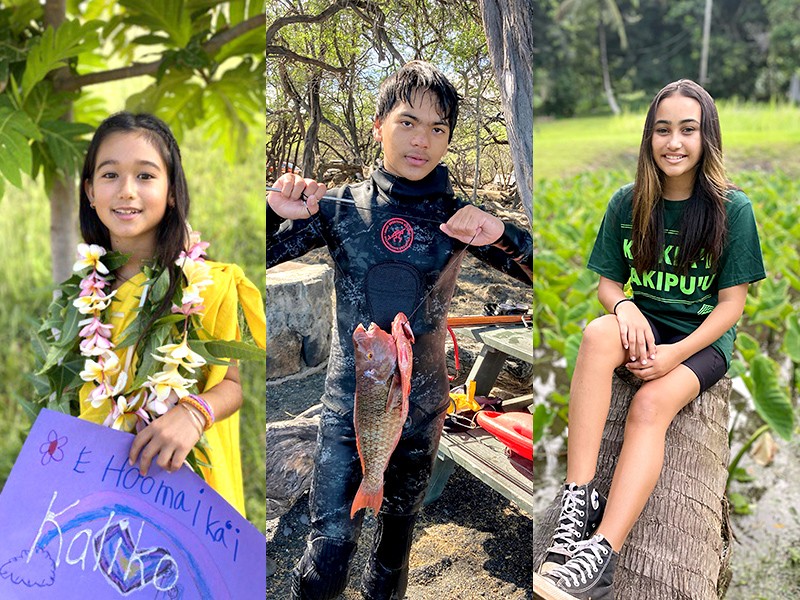As Tropical Storm Olivia bore down on the island of Maui in September 2018, Kaliko and her family grabbed their most important belongings and fled. The storm inundated the island with more than a foot of rain, and the floodwater lifted Kaliko’s home from its foundation and washed part of it away. Now, 11-year-old Kaliko is one of 14 youth suing the State of Hawaii for failing to adequately reduce greenhouse gas emissions to protect them from the worsening dangers of climate change.
In a lawsuit filed yesterday, the young plaintiffs allege that the director of Hawaii’s Department of Transportation, Jade Butay, the department itself, Governor David Ige, and the State of Hawaii are violating their constitutional rights by failing to reduce emissions from the transportation sector. In Hawaii, the state constitution has guaranteed each person since 1978 “the right to a clean and healthful environment.” Climate change threatens that right. But when it comes to decarbonizing the state’s largest source of greenhouse gas emissions — transportation — the plaintiffs say state leadership has been asleep at the wheel.
“What we want is for the Transportation Department to start doing the things it’s already supposed to be doing to help mitigate climate change,” said Leināʻala Ley, an attorney with Earthjustice and a co-counsel for the case.
The Department of Transportation did not respond to a request for comment, and Governor Ige’s office declined to comment on the pending litigation.
The State of Hawaii recognizes that climate change is an existential threat. Last year, it became the first state in the U.S. to declare a climate emergency. Three years before that, Governor Ige signed a law committing the state to becoming carbon neutral by 2045. In many ways, Hawaii has been a climate leader — but not when it comes to the transportation sector. If the state continues on its current trajectory, by 2030 the emissions will have increased by 41 percent from 2020 levels, according to the state’s most recent emissions report.
Earthjustice and Our Children’s Trust — the two organizations representing the 14 plaintiffs — chose to focus on the Department of Transportation because there is much more it could and should be doing, Ley said. There are statutes that require the agency to take steps to cut emissions, like reducing vehicle miles traveled and improving pedestrian and bike pathways, “but the state Department of Transportation isn’t meeting any of these goals and mandates that are already on the books,” Ley said.

“We have the tools in our hands to fix the climate crisis, we just have to have the political will to do that,” she added. “This lawsuit can help push the government in the right direction.”
Today’s youth have the most to lose if we don’t act quickly to address climate change. The personal stories of the youth plaintiffs, who are between 9 and 18 years old and come from across the Hawaiian Islands, illustrate how climate change is already affecting the region. Fourteen-year-old Navahine and her family maintain a fishpond, but polluted runoff from unusually heavy downpours and rising sea levels threaten the Native Hawaiian practice. “If urgent reductions in greenhouse gas emissions are not made, these lands will most likely be underwater within my lifetime. And if that happens, our legacy and our future on this island will be lost,” she told Grist.
Ka‘ōnohi, 15, is a diver and spearfisher, but ocean acidification and rising temperatures have caused wide-scale bleaching and die-offs of Hawaii’s once-vibrant reefs. Others have had their homes threatened by intensifying storms, their roads washed away by flash floods, and their food and water security torn away by the changing climate.
In previous cases, youth have sued the federal government and other state governments over climate inaction. In 2015, 21 young people filed a lawsuit against the federal government in a case called Juliana v. United States, or Youth v. Gov. Five years later, a federal appeals court dismissed the lawsuit, writing that the issue should be addressed by the executive and legislative branches, rather than the courts, but now the plaintiffs have filed an amended complaint.
Recently, activists have been trying a different tactic, filing lawsuits in places like Hawaii, where the state constitution guarantees the right to a clean and healthful environment. Similar cases are also pending in Utah and Montana, but the outcomes are still uncertain.
As kids, it can be frustrating “to constantly feel like our voice isn’t heard in these big conversations about our future,” said Navahine, the lead plaintiff. “These decisions that are made regarding climate change are going to impact my generation and the generations after us the most.” She sees this lawsuit as a way for her and her peers to make their voices heard.
Though it feels a bit overwhelming, she said, “I do know that it’s the right thing to do. And I really hope that it makes an impact.”



